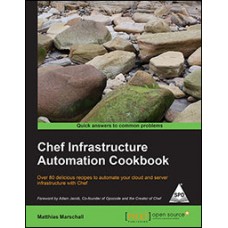Chef Infrastructure Automation Cookbook
What you will learn from this book
- Define your infrastructure as code with Chef
- Set up your local development and testing environment for Chef with cookbooks and Vagrant
- Debug your cookbooks and Chef runs by using the numerous inspection and logging facilities of Chef
- Write clean and maintainable cookbooks by following established coding standards and patterns
- Drive your cookbooks from external data or node specific attributes by using data bags and search
- Manage and scale your cloud infrastructure by automating your configuration management
- Extend Chef to meet your advanced needs by creating custom plugins for Knife and Ohai
- Test your Chef cookbooks and infrastructure by writing examples using Chef's testing infrastructure
In Detail
Irrespective of whether you're a systems administrator or a developer, if you're sick and tired of repetitive manual work and not knowing whether you may dare to reboot your server, it's time for you to get your infrastructure automated.
Chef Infrastructure Automation Cookbook has all the required recipes to configure, deploy, and scale your servers and applications, irrespective of whether you manage 5 servers, 5,000 servers, or 500,000 servers.
Chef Infrastructure Automation Cookbook is a collection of easy-to-follow, step-by-step recipes showing you how to solve real-world automation challenges. Learn techniques from the pros and make sure you get your infrastructure automation project right the first time.
Chef Infrastructure Automation Cookbook takes you on a journey through the many facets of Chef. It teaches you simple techniques as well as fully fledged real-world solutions. By looking at easily digestible examples, you'll be able to grasp the main concepts of Chef, which you'll need for automating your own infrastructure. Instead of wasting time trying to get existing community cookbooks running in your environment, you'll get ready made code examples to get you started.
After describing how to use the basic Chef tools, the book shows you how to troubleshoot your work and explains the Chef language. Then, it shows you how to manage users, applications, and your whole cloud infrastructure. The book concludes by providing you additional, indispensable tools and giving you an in-depth look into the Chef ecosystem.
Chef Infrastructure Automation Cookbook will help you learn the techniques of the pros by walking you through a host of step-by-step guides to solve real-world infrastructure automation challenges.
Approach
Chef Infrastructure Automation Cookbook contains practical recipes on everything you will need to automate your infrastructure using Chef. The book is packed with illustrated code examples to automate your server and cloud infrastructure.
The book first shows you the simplest way to achieve a certain task. Then it explains every step in detail, so that you can build your knowledge about how things work. Eventually, the book shows you additional things to consider for each approach. That way, you can learn step-by-step and build profound knowledge on how to go about your configuration management automation.
Who this book is for
This book is for system engineers and administrators who have a fundamental understanding of information management systems and infrastructure. It helps if you've already played around with Chef; however, the book covers all the important topics you will need to know. If you don't want to dig through a whole book before you can get started, this book is for you, as it features a set of independent recipes you can try out immediately.
About the Author
Matthias Marschall is a software engineer "Made in Germany". His four children make sure that he feels comfortable in lively environments, and stays in control of chaotic situations. A lean and agile engineering lead, he's passionate about continuous delivery, infrastructure automation, and all things DevOps. In recent years, Matthias has helped build several web-based businesses, first with Java and then with Ruby on Rails. He quickly grew into system administration, writing his own configuration management tool before moving his whole infrastructure to Chef in its early days. In 2008, he started a blog (http://www.agileweboperations.com) together with Dan Ackerson. There they shared their ideas about DevOps since the early days of the continually emerging movement. You can find him on Twitter as @mmarschall. Matthias is a CTO at gutefrage.net GmbH, helping run Germany's biggest Q&A site among other high-traffic sites. He holds a Master's degree in Computer Science (Dipl.-Inf. (FH)) and teaches courses on Agile Software Development at the University of Augsburg. When not writing or coding, Matthias enjoys drawing cartoons and playing Go. He lives near Munich, Germany.
| Book | |
| ISBN | 9789351105169 |
| Pages | 292 |
Enter the code in the box below:



